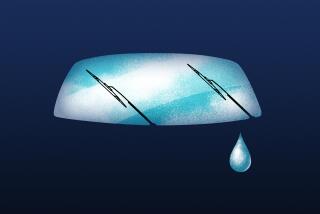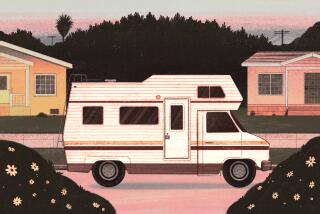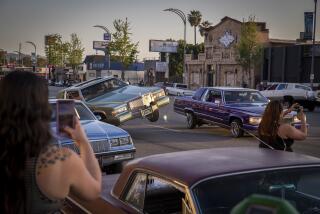Spoil the Rod : O.C. Owners Are Spending Small Fortunes on These Babies
LAKE FOREST — It’s hard to be sure whether that rapid, throaty whapping sound is coming from a blown Chevy engine or from the fibrillating heart of some horrified automotive purist who just got a look at the car that engine is stuffed into.
You can hear it a couple of blocks away, a kind of primal rumble, like distant thunder. Then down El Toro Road it comes, snapping heads and rattling chests with the kind of gut-level thrumming that used to be the trademark for SenSurround.
And as it eases, backward, into a parking slot in front of Fuddrucker’s restaurant, heads around the parking lot nod in appreciation, and at least one visitor is bound to wonder if that pile of pure automotive muscle could have once actually looked anything like a 1932 Ford.
But that’s what it is. Or, rather, was. Tonight, it, and a couple dozen of its brethren, are a manifestation of true, true love, Southern California style. Tonight is cruise night at Fuddrucker’s, and the South County hot rod crowd is in its glory.
It’s a ritual that happens several nights each week in and around Orange County: Garages open and legions of gleaming, roaring, startlingly pristine vintage hot rods ease into traffic and head for the local pizza or burger joint, where they . . . park. And then the owners and their spouses and friends ogle each other’s handiwork, talk technical talk, sip iced tea and generally bask in the reflected glow of the sorts of machines that they used to dream about, and that they now own.
There are a handful of car clubs in Orange County devoted exclusively to the elusive kind of car that has come to be known as the hot rod. Ed Beckman, the president of Saddleback Rods, the only club in the South County, said there are probably 400 hot-rod owners in Orange County, but not all of them are affiliated with clubs. They get together regularly at such places as Fuddrucker’s, and occasionally at larger spots, such as shopping center parking lots and fairgrounds, where the number of rods on display can run into the hundreds.
“The great thing about Southern California is that there’s something like this going on all the time,” Kenny Watkins said happily as he surveyed the now-gleaming parking lot at Fuddrucker’s.
Watkins, 49, a mechanic from El Toro, is a newcomer to the local hot-rod world. He’s currently slapping together his very first rod, a 1933 Ford Victoria (call it a “Vicky”), but he doesn’t want to miss a cruise night, even though the car isn’t finished yet.
“I just decided I wanted to build a hot rod,” he said, echoing a kind of serendipity that isn’t unusual among the car owners. “I never had any money to do it when I wanted one when I was younger, so . . .”
Mike Miller, 40, is another enthusiast who, like so many other current hot-rod owners, barely missed owning one during his younger days.
“I was going to build a ’23 Model T when I was 18,” said Miller, who lives in Trabuco Canyon and is putting the finishing touches on a 1932 Ford 2-door Model B sedan. “But I bought a brand-new Monte Carlo instead.”
The need for speed (and for a really flashy set of wheels) kept gnawing at him, though, and when Miller and his wife bought a house about five years ago, “I stipulated that it had to have a three-car garage so I could build a hot rod.”
And he did, piece by piece. A painting contractor, Miller said he “didn’t know a thing about cars” and learned as he went along, reading technical manuals and buying individual parts when he could afford them. Now, the formerly sedate sedan carves up the road courtesy of a 400-cubic-inch turbocharged Chevy engine that Miller fitted under the hood.
“It’s definitely a runner,” he said, “and women like it because it’s the only baby-blue hot rod around.”
Miller figures he’s sunk about $25,000 into his baby-blue bomb but estimates that when it’s finished it’ll be worth around $35,000 to $40,000.
“You don’t lose any money on ‘em,” said Bob Lakin 51, a computer electronics designer from Mission Viejo who has built and sold several rods.
For instance, Lakin said, he bought his ’34 Ford convertible for $800 originally (remember, this is stock, and probably not in wonderful shape). Today, after tricking it out with a new, sleek interior and a 350-cubic-inch Corvette V-8 engine and a spotless chassis, Lakin said he thinks he can sell it for $65,000.
But don’t call it a restoration job. These cars are about as close to original factory specs as an F-18 is to a unicycle. Hot rods typically are either built from scratch, using original bodies and chassis, or from Fiberglas kits (for the body) and custom chassis and engines. But they are not restoration jobs. When a hot-rod builder sees, say, a stock ’34 Ford three-window coupe, he doesn’t see an object of pristine automotive reverence. He sees raw materials, materials to be chopped, channeled, raked, lowered, modified, adorned, souped up and buffed to a shine that GM can only dream about.
Every hot rod is unique. Not only are these cars not your father’s Oldsmobile, they aren’t even Oldsmobile’s idea of an Oldsmobile. Think of a family car designed by Salvador Dali, or a jalopy made to order for the Tasmanian Devil. They’re about as practical and utilitarian as a cement bicycle, and it’s entirely possible to throw tens of thousands of dollars into assembling one (although rodders say that it can be done for much less).
For instance, Rich Davis, 52, a Santa Ana firefighter who lives in San Clemente, points to his gleaming orange ’55 Chevy and admits that “nothing’s original on it except the body. Nothing.” New interior. A 10-disc CD player in the trunk. A huge, muscular, custom V-8 under the hood. Even the frame came from a ’56 Chevy. But it’s a thing of beauty, and Davis’ baby, his first rod.
“You can’t believe the interest in these old cars,” he said. “And the fun of having them is actually being able to drive them. You can’t just lock them in a vault somewhere.”
Why build and own a rod? That question actually puzzles some rodders for a few seconds. Two days after the Fuddrucker’s cruise night, a similar gathering took place at a Wienerschnitzel in Laguna Hills and the crowd groped for an explanation.
“It’s just . . . fun,” said Beckman, possibly wondering how anyone could fail to recognize the appeal of it all. But then Beckman and a few others began chipping in other reasons: camaraderie among enthusiasts, friendships, talk among kindred spirits, the festive atmosphere of cruise nights, the pure joy of owning something that absolutely no one else has.
And the availability of technical advice, and even a few extra pair of hands. John Marshall, 50, an airline pilot from Mission Viejo, said that he got good advice and help from local rodders while he was building his own ’37 Ford 4-door sedan in his driveway.
“Like a lot of guys, I always wanted one but could never afford it,” said Marshall. “Then I ran into all these guys with similar interests, and it turned into a community effort.”
Today, the car is an eye-popper, needle bright and muscular, with a 300-horsepower Chevy V-8 under the hood. The license plate reads “REVN 37.”
“The original 60 horsepower just wasn’t enough,” said Marshall, grinning.
The original, for any rodder, is never enough. A look around the parking lot on cruise nights reveals custom components with bewitching brand names, names that entranced car-crazy kids in, particularly, the late ‘50s and early to late ‘60s: Moon, Edelbrock, Holley, Cragar, Hurst. Everywhere are wide-wide tires; sparkling chrome and aluminum undercarriages, air cleaners and valve covers; towering blowers; angry, wide drive belts; custom paint jobs that look 10 feet thick; fuzzy dice hanging from rear-view mirrors; even valve stem caps that look like little eight-balls.
And nearly everywhere, from the venerable 1930s Fords to the late-1960s Novas, the giveaway: huge, leering custom tachometers, jutting from the steering column and staring at the driver like a Cyclops, the one essential piece of instrumentation for a car that can be heard before it can be seen.
Beckman remembered when such tachs got a lot of use: back in the ‘60s, on legendary Whittier Boulevard, nearly every night. He remembered when cruising meant circling the Bob’s Big Boy parking lot three times--slowly--to let everyone get a look at you “and then maybe you’d go out and race and then come back for a patty melt and a lemon Coke.”
Today, said Marshall, cruising mostly means traveling to an agreed-upon spot for a burger, some iced tea and a lot of static display.
“It’s not like the old days, drinking and drag racing,” he said, nodding at the lot full of breathtaking machines. “These things cost too much. There’s a ’41 pickup in one club that’s probably worth $120,000.”
Jerry Hill’s car, a ’66 Mustang convertible, is more modest--he said he has turned down $30,000 for it--but Hill doesn’t appear to love his creation any less. Hill, 61, a retired mobile home park builder from Corona del Mar, said building the car--with parts from four separate cars--had “opened new doors to me and kind of helped me keep a hold on the past. It fills a lot of time for me and it’s a real conversation piece.” The car has, in fact, become a part of the Hill family. So wrapped up has Hill become with the Mustang that his children have begun, he said, to refer to it as his “wife.”
And, he added, they always leave him with an admonition: “Don’t sell your wife, Dad.”






